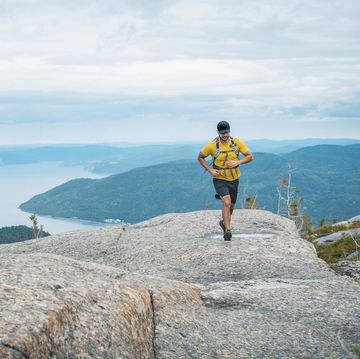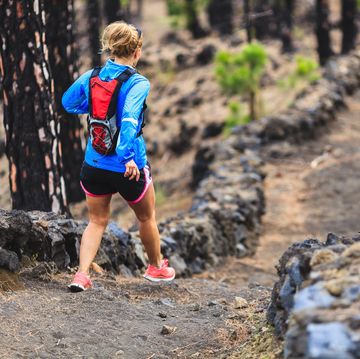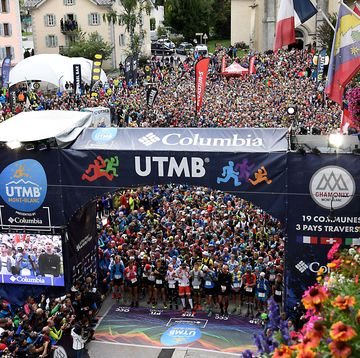The beauty of running is that it can take you to all kinds of amazing places: to the roads, to the trails, to local running clubs, to major marathons, to new friends, to a better headspace and sense of wellbeing – and so on.
But would you ever let your running take you to some of the most intense environments on earth – from the majestic Artic Circle to the mystical peaks of Kyrgyzstan? If so, the Global Race Series could be your next extraordinary running endeavour.
Organised by Beyond the Ultimate, the Global Race Series encompasses four unique and challenging multi-stage ultramarathons – held in the desert, on ice, in the jungle and up in the mountains – which enable adventurers to break well beyond their everyday running routines and immerse themselves in spectacular natural landscapes.
What everyone's reading
However, training for these kinds of quests is no walk in the park. Whether you’re tackling the blistering heat of the desert, the sticky humidity of the jungle, the sub-zero temperatures of the Artic or the breathtaking altitude of the mountains, you’ll need to adjust your training, gear and mindset accordingly. So, to help you conquer next-level ultramarathon environments, we spoke with Kris King, founder and Race Director of Beyond the Ultimate, for expert advice on how to defy the elements.
Desert
One of the greatest challenges of a desert race is the temperatures that you’ll face along the way. Heat of over 50C can consume the day, while freezing conditions arrive at night – and that’s not to mention all the sand dunes along the way. Beyond the Ultimate’s Desert Ultra is a 250km self-sufficient footrace across Namibia’s Namib Desert. It is one of the oldest and harshest deserts in the world, but also one of the most beautiful.
What gear do I need for a desert ultramarathon?
‘You’ll need lightweight, breathable clothing with UV protection to prevent overheating,’ says King. ‘A hat with a neck flap is essential and shoes with gaiters will help to keep sand out, preventing blisters. Studies show that once skin is burned, it can become up to 30% less effective at sweating, so protect yourself with sunblock and proper clothing to help regulate your body temperature.’
What should I focus on in training?
According to King, acclimatising yourself to heat close to race day is key. ‘Focus on long runs during the hottest part of the day,’ he advises. ‘If you don’t live in a hot country, you can use a heat chamber or sauna to help you acclimate to high temperatures.’
King also suggests working on your speed before a desert race. ‘Speed is beneficial for desert races, as most races start early when it’s cooler – and minimising exposure to the heat can make all the difference. If you live in a hilly area, prioritise flat running to adapt to the long, flat desert terrain. Running on the flat is almost a different skill to running on inclines.’
What surfaces should I train on?
While King says that soft sand simulates desert terrain and is the ideal surface to train on, he is aware that most people don’t have sand on their doorstep. ‘If dunes aren’t available, loose gravel or uneven surfaces will do. As an insider tip: check out horse training areas – they often have sandy loop tracks or sandpits. If not, head to the beach!’
How should I manage hydration and fuelling?
‘Hydration is critical in desert environments,’ affirms King. ‘Practice carrying water during long runs and aim to drink little and often. Electrolytes are just as important as water to avoid dehydration and cramping. It’s a fine balance and can vary from person to person, so practice and adjust during training.’
How can I mentally prepare for a desert ultramarathon?
It should come as no surprise that a desert ultramarathon will be void of the vibrant crowds and loud fanfare that you’d find in a big city race. Instead, you’ll likely find yourself out there almost alone, with just your own quiet thoughts for company. ‘Mentally prepare for monotony, as desert landscapes are often desolate and don’t change much,’ says King. ‘Long solo runs on flat terrain will help you to get used to the isolation.’
The next edition of Beyond the Ultimate’s Desert Ultra will start on 17 November 2025 – find out more about the event here.
Jungle
Beyond the Ultimate’s immense Jungle Ultra is held in Peru’s Manu National Park, situated deep in the heart of the Amazon Rainforest. Billed as the ‘hardest ultramarathon’ in the Global Race Series, it sees runners battle relentless humidity, undergrowth and river crossings for 230km, testing mind and matter in an iconic corner of the world.
What gear do I need for a jungle ultramarathon?
In the jungle, wet conditions will become your friend – or, at the very least, something that you’ll have to tolerate. ‘Breathable clothing is essential, along with trail shoes with excellent grip for navigating muddy, slippery terrain,’ says King. ‘Insect repellent is also a must and don’t bother waterproofing anything – just expect to get wet.’
What should I focus on in training?
‘Heat and humidity training should be your priority, so regular runs in humid conditions will help you to adjust,’ notes King. ‘If you do not live in a warm or humid country, you can gain many benefits from some standard heat acclimatisation in a heat chamber or sauna. Full-body strength work is also crucial when it comes to handling the terrain, as you’ll likely need to scramble over obstacles.’
What surfaces should I train on?
Thanks to the squelchy conditions you’ll face in the jungle, the best surfaces you can train on in the build-up to your race are muddy trails and riverbeds. ‘If these aren’t available, technical trails with roots, rocks and other obstacles will suffice,’ adds King. ‘You’ll also need to practise your sighting and keeping your brain engaged when tired.’
How should I manage hydration and fuelling?
‘In high humidity, you’ll sweat far more than expected, so practise carrying fluids,’ says King. ‘To maintain balance, hydration with electrolytes is vital.’
How can I mentally prepare for a jungle ultramarathon?
Above all, King recommends learning how to stay calm under pressure. ‘The jungle is unpredictable, with heat, rain and wildlife constantly changing your surroundings. Practise adapting quickly and staying mentally strong. My favourite mantra is this: “Strong system, adaptive plan.”’
The next edition of Beyond the Ultimate’s Jungle Ultra will start on 1 June 2025 – find out more about the event here.
Ice
If you’ve ever wondered what it feels like to traverse a wintry wilderness, then Beyond the Ultimate’s 230km, self-sufficient Ice Ultra could be your calling. Held in Sweden’s stunning but savage Lapland, this race presents frozen lakes, energy-sapping snowfields, tough Artic tundra and daytime temperatures that can dip as low as -40C.
What gear do I need for an ice ultramarathon?
‘A modular clothing system is key,’ says King. As a basic set-up, he suggests getting hold of a base layer that wicks away sweat from the body, a warm layer that traps heat and an outer shell that protects you from the elements and keeps you dry. He also recommends carrying an optional second warm layer, which could become necessary if you find yourself in temperatures below -20°C.
What should I focus on in training?
In an ice ultramarathon, King says that you are more likely to encounter soft or fresh snow than hard-packed trails. As such, doing some of your training runs on soft sand will have some crossover benefits. ‘I also recommend adding long hikes to the end of your runs to get used to spending more time on your feet at a slower pace,’ he suggests.
How should I manage hydration and fuelling?
‘In freezing conditions, it’s easy to forget to drink, but dehydration remains a serious risk,’ says King. ‘Use insulated containers to prevent water from freezing and avoid straws if possible. If you use a hydration bladder, make sure to blow the water out of the straw after each drink to prevent freezing. Test calorie-dense foods in your freezer to ensure they stay edible in cold conditions, too. Shortbread works well!’
How can I train my mindset for an ice ultramarathon?
While you are not expected to live in an ice chamber, getting accustomed to cooler climates during training will serve you well for your race. ‘Controlled exposure to cold temperatures before the race will help with acclimatisation and confidence,’ says King. ‘Although cold water exposure is debated, it can build discipline and mental toughness. Try cold showers or ice baths to boost resilience as well.’
The next edition of Beyond the Ultimate’s Ice Ultra will start on 18 February 2025 – find out more about the event here.
Mountains
Perhaps better known in the ultramarathon world are mountain races. After all, we have the legendary UTMB World Series Finals in Chamonix, France, alongside various other trail adventures in the Alps. But how about a 200km trail run in the vast but lesser-explored Tian Shan Mountain Range in Kyrgyzstan? That’s the itinerary for Beyond the Ultimate’s Mountain Ultra, which asks runners to navigate technical, rocky terrain while staying resilient in thin air.
What gear do I need for a mountain ultramarathon?
‘You’ll need versatile gear for changing weather, lightweight layers, a reliable, well-tested waterproof jacket and sturdy trail shoes with strong grip,’ advises King. ‘Trekking poles can be extremely useful for steep ascents and descents.’
What should I focus on in training?
According to King, hill work is crucial for building leg strength and endurance. ‘Incorporate long climbs and descents into your routine and track the total metres climbed each week, rather than your mileage,’ he says. ‘Gradually increase the elevation until you’re comfortable with the demands of the race. Mountains are unpredictable, so train in varied weather conditions, including rain and wind. Practice layering your clothing to stay warm and dry. You need to train in all sorts of weather to gain as much experience as possible.’
What surfaces should I train on?
King says that running on rocky, uneven trails is ideal preparation for a race of this ilk. ‘The more technical and steep these trails are, the better prepared you’ll be for mountain conditions,’ he adds.
How should I manage hydration and fuelling?
‘Plan to carry extra fuel,’ asserts King, noting the importance of eating and drinking regularly in mountain environments. ‘High altitude and long climbs burn calories quickly, and your appetite may be suppressed at altitude. Hydrate with a balance of water and electrolytes and carry a variety of high-energy snacks.’
How can I train my mindset for a mountain ultramarathon?
Mental strength, says King, is just as important as physical strength when it comes to facing the mountains. ‘Mountain ultras are about resilience,’ he states. ‘Tough climbs and exhausting descents will test you repeatedly, so train your mind to stay positive during challenging efforts. In addition, sprint work can help you to become comfortable with discomfort.’
The next edition of Beyond the Ultimate’s Mountain Ultra will start on 28 July 2025 – find out more about the event here.

















